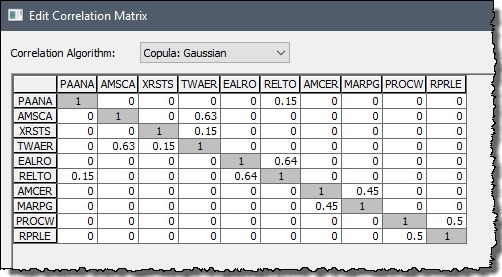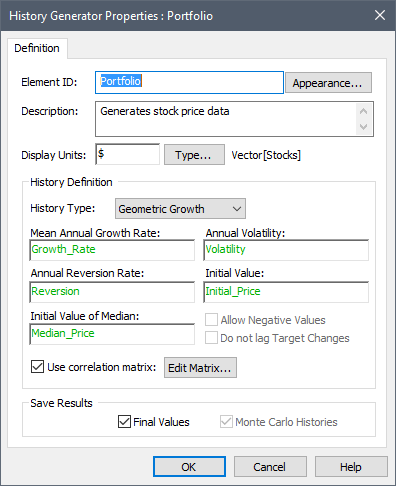Advanced Probabilistic Modeling Features
Lesson 5, page 4 of 15
In the Tutorial example, we explored some of GoldSim's basic probabilistic modeling capabilities.However, GoldSim was designed from the outset to be a very powerful probabilistic simulator, and as a result, provides a large number advanced probabilistic modeling features that we were not able to discuss, including the following:
- In most
probabilistic models, it is critical to represent the degree of correlation
between uncertain variables. GoldSim supports this, including the ability to
define a correlation matrix A two-dimensional array. to express how
multiple variables are correlated:

- When representing a randomly sampled series of data (as we did in the Tutorial example to represent the inflow rate), it is often critical to define the degree to which the successive samples are correlated in time (referred to as autocorrelation). For example, if the flow rate is high today, how likely is it to be high tomorrow? GoldSim allows you to define such auto correlations.
Note: Another possible way to more realistically have represented the inflow rate to the pond in the Tutorial example would have been to specify an autocorrelation factor for the Stochastic An Input element that allows you to quantitatively represent the uncertainty in a model input by defining it as a probability distribution. element.
- GoldSim provides a number of advanced Monte Carlo sampling options (e.g., Latin Hypercube sampling A stratified sampling method that has the effect of better ensuring that the space of the parameter is uniformly spanned., importance sampling, nested Monte Carlo A specialized type of Monte Carlo simulation that explicitly separates (i.e., separately samples) variables representing uncertainty from those representing variability.) to improve the flexibility and computational efficiency of probabilistic models.
- GoldSim
provides an advanced element called a History Generator An element that generates stochastic time histories of variables. A stochastic time history is a random time history that is generated according to a specified set of statistics.. This element can
be used to generate a wide variety of stochastic time histories based on
specified statistical measures (e.g., growth rate, volatility). It is
particularly useful for representing financial and economic variables (but has
applications in many other arenas) that can be described as being controlled by
either a random walk or geometric growth process:

- One of the
key purposes of probabilistic simulation A simulation in which the uncertainty in the input parameters is explicitly represented by defining them as probabilility distributions. modeling
is not just to make predictions, but to identify those parameters that are
contributing the most to the uncertainty in results. By doing so, you can
determine the most effective way to reduce the uncertainty in your predictions.
GoldSim provides a number of tools for carrying out such analyses:

- GoldSim was designed to provide a highly efficient probabilistic simulation framework for use on a single computer.For most applications, running your GoldSim application on a single computer will be sufficient.For highly complex models, however, running Monte Carlo simulations on a single computer could become impractical. For example, if each realization A single model run within a Monte Carlo simulation. It represents one possible path the system could follow through time. took one minute to complete, then 1000 realizations would take over 16 hours. The GoldSim Distributed Processing Module allows you to overcome this problem by combining the power of multiple cores and/or computers to carry out complex probabilistic simulations.